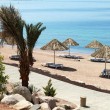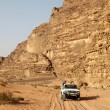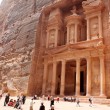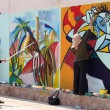| Skrevet af TravelHunter | 3. juni 2012, 17:53 |
Experience the sun from the blue sky over the sea, desert and rock city of Petra in the kingdom of Jordan. Use Aqaba as your holiday base and get unique experiences both on land and underwater, and insight into Arabic culture in one of the Middle East’s most peaceful countries. Just go!
Aqaba lies in a cultural and religious triangle. In the Arab hinterland, you can take an excursion to historic destinations and enjoy Arabic bedouin culture, e.g. in the amazing desert landscape of Wadi Rum and the ancient Petra with Al Khazneh as the city’s crown jewels. Or you can laze on the beaches on the 27 km long coastline along the Red Sea and dive and snorkel in the coral reefs or read crime novels, bobbing in the sea level at the Dead Sea.
Aqaba city center
In Aquaba visit the 500 year old sandstone-colored castle, situated on the edge of the Red Sea. You can visit the bustling bazaar area, which sells sweets and salted and smoked pistachios and enjoy the cool smoke from the beautifully decorated hookahs on one of the cafes. Visit Al-Sharif Al Hussein Bin Ali Mosque, where you and a local guide has the opportunity to enter the mosque and see the Koran, but you must cover their legs and hair.
Beaches around Aqaba
Berenice Beach is a newly built beach area with both pools and beach, approx. 8 km from Aqaba. Coral reefs begins 50 meters from the beach, and you can spend hours snorkeling over the coral and watching the colorful fish. Or you can take a Discovery glass boat from Tala Bay, 13 km from Aquaba and see coral reefs and myriads of fish through a large glass bottom. Check sinbajo.com
The Wadi Rum desert
An overnight stay in Wadi Rum at a Bedouin camp to capture the brilliance of the desert, is something you has to try once.
The Visitors Centre for Wadi Rum is approx. 30 kilometers from Aqaba. Rugged sandstone mountains in strange formations spread beyond the giant desert area, which looks almost pink in the day and switches to deep orange in the evening.
It was in Wadi Rum that the British officer and author of “Lawrence of Arabia” fought against the Ottomans along with the Arab rebel army. But bedouins have lived in Wadi Rum for thousands of years and moved around with their tents and livestock. You can get a glimpse into the nomadic life when you’re sitting around the campfire in the evening and spend the night in a tent woven from goat hair.
The Dead Sea
In the Dead Sea, you can sit back in the water and float like a cork with a good book in your hands. The Dead Sea lies on the earth’s lowest point, approx. 400 m below sea level. The water contains 38% salt, ten times more than the Mediterranean, and contain several charitable minerals, which you only get benefit from, if you let the sun dry your body after your swim in The Dead Sea. There are plenty of “Free Mud” which also contains minerals and is good against psoriasis.
Petra
The red rock city Petra was carved into the rocks several thousand years ago by the tribal people The Nabataeans and belongs to is one of the world’s seven new wonders. Petra was the trading post for trade men, Arab camel traders and Syrian merchants and was hidden for over 1000 years. The city was rediscovered by the Swiss, Johann Ludwig Burckhardt, in 1812 and is on UNESCO World Heritage List.
Discover the 43 meter high facade of Petra’s crown jewel Al Khaznehs, which is 30 meters wide and equipped with high columns and beautiful ornaments. In the wide valley around Petra, you will find numerous beautiful temple facades, old baths and huge royal tombs and small caves, where the Bedouins of Petra lived until the 1980s.
If you follow the 800 steps to the Al-Deir Monastery, you will find the largest monument in Petra, The Monastery, which was the tomb of King Obodas of the Nabataeans.
Travel Hunter was invited by GO-TO-JORDAN.







 Follow
Follow
Speak Your Mind